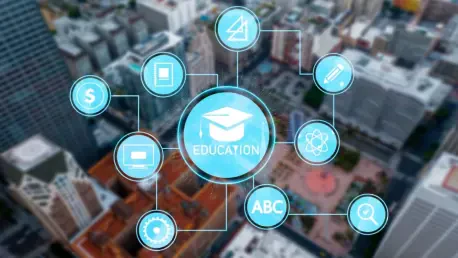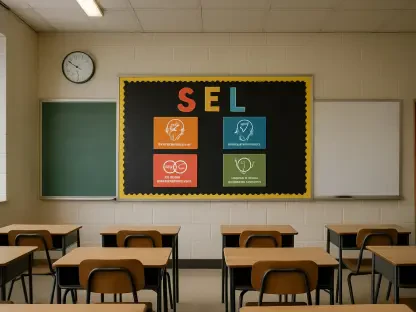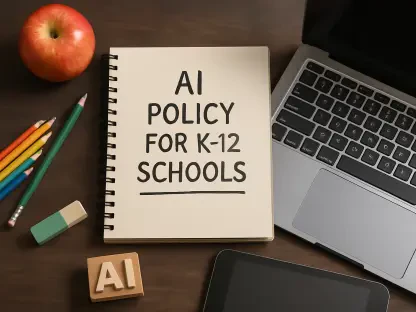The adoption of Learning Management Systems (LMSs) in Agricultural Higher Education (AHE) in Iran has emerged as a pivotal focus, driven by the paradigm shift during the COVID-19 pandemic. This exploration seeks to validate an integrated model blending the well-established Technology Acceptance Model (TAM) with the Technology-Organization-Environment (TOE) framework to better understand the driving factors behind LMS adoption.
Technological advancements have profoundly reshaped traditional educational methods, offering unprecedented interactive and remote learning capabilities. Key technologies include LMSs, artificial intelligence (AI), and virtual reality (VR), all of which have added a new layer of innovation to the educational landscape.
Technological Advancements in Education
The Emergence of New Learning Tools
The advent of advanced learning tools like LMSs, AI, and VR has transformed the educational landscape, making learning more accessible and engaging. LMSs facilitate seamless access to information and collaborative learning, allowing students to participate in discussions, submit assignments, and receive feedback in a streamlined manner. AI technologies further enhance the experience by personalizing learning paths, adapting to students’ progress, and providing intelligent tutoring systems. Simultaneously, VR presents immersive environments where learners can interact with 3D models and simulations, offering practical, hands-on experiences that traditional methods lack. Together, these technologies create a dynamic and interactive learning environment that caters to diverse educational needs.
Breaking Geographical Barriers
Technological advancements have also played a critical role in bridging geographical gaps, enabling students to access educational resources and participate in courses from anywhere in the world. This global connectivity has democratized education, allowing learners from remote or underserved regions to benefit from quality education previously unavailable to them. Through online platforms, students can join live classes, engage in collaborative projects with peers from different countries, and access a wealth of digital resources. This unprecedented access not only broadens their educational horizons but also fosters a diverse learning community, enriching their academic experience. Such connectivity ensures that education is no longer confined by physical boundaries, promoting inclusivity and equal opportunities for all learners.
Personalized Learning Environments
Personalized learning environments, made possible by AI and other advanced technologies, offer customized educational experiences tailored to individual student needs. These environments adapt to students’ learning styles, preferences, and progress, providing targeted resources and support to enhance their learning outcomes. By analyzing data on students’ performance and engagement, AI systems can suggest personalized study plans, recommend relevant content, and even predict potential challenges, allowing educators to intervene proactively. This level of personalization ensures that each student can learn at their own pace, receive immediate feedback, and stay motivated throughout their educational journey. The result is a more effective and engaging learning experience that maximizes students’ potential and fosters a deep understanding of the subject matter.
The Impact of COVID-19 on Education
Rapid Shift to Remote Learning
The COVID-19 pandemic precipitated a swift transition to remote learning, underscoring the critical role of LMSs in maintaining educational continuity. As traditional classrooms became inaccessible, educational institutions worldwide turned to online platforms to deliver courses and facilitate student-teacher interactions. LMSs emerged as essential tools, providing a centralized hub for managing coursework, assessments, and communication. This rapid shift highlighted the versatility and resilience of digital learning systems, ensuring that education could continue uninterrupted despite global disruptions. However, the sudden transition also revealed significant disparities in technological readiness among institutions, emphasizing the need for robust infrastructure and comprehensive digital literacy training for educators and students alike.
Challenges and Adaptations
The accelerated adoption of remote learning presented numerous challenges, necessitating swift adaptations by educational institutions. One of the primary obstacles was the digital divide, with many students lacking access to stable internet connections and appropriate devices for online learning. Additionally, educators faced difficulties in adapting their teaching methods to virtual environments, requiring extensive training and support. Despite these hurdles, institutions demonstrated remarkable resilience and innovation, implementing measures such as issuing loaner devices, enhancing IT support, and developing new pedagogical strategies. These adaptations not only addressed immediate challenges but also laid the groundwork for more flexible and inclusive educational models moving forward.
Long-term Changes
The pandemic-induced shift to remote learning is likely to have long-lasting implications for the adoption and use of LMSs in education. The experience underscored the importance of digital literacy, prompting educational institutions to invest more heavily in technology infrastructure and training programs. It also sparked greater acceptance of blended learning models, combining online and in-person instruction to provide more flexible and personalized educational experiences. As a result, LMSs are expected to remain integral components of the educational landscape, facilitating continuous learning, fostering collaboration, and bridging gaps in access to quality education. The lessons learned during this period will inform future educational strategies and policies, ensuring that institutions are better equipped to navigate potential disruptions and embrace the full potential of digital learning.
Integrating TAM and TOE Models
The Technology Acceptance Model (TAM) and the Technology-Organization-Environment (TOE) framework are both critical in understanding technology adoption. By integrating the two models, researchers can gain a comprehensive view of the factors influencing organizational decisions to adopt new technologies. TAM focuses on the perceived ease of use and usefulness of the technology, while TOE considers the technological, organizational, and environmental contexts. Combining these models allows for a more holistic approach, ensuring that both individual user perspectives and broader organizational factors are taken into account when examining technology adoption rates and processes. This synthesis of models provides a robust framework for analyzing the multifaceted nature of technology acceptance in various business environments.
Technology Acceptance Model (TAM)
The Technology Acceptance Model (TAM) offers a robust framework for understanding how users come to accept and utilize technology. Central to TAM are two key perceptions: Perceived Usefulness (PU) and Perceived Ease of Use (PEU). PU refers to the users’ belief that the technology will enhance their performance, while PEU relates to how effortless the technology is to use. In the context of LMS adoption, these perceptions play a significant role. Students and educators are more likely to adopt LMS if they believe it will improve their learning or teaching efficiency and find it user-friendly. TAM provides valuable insights into personal attitudes and motivators, helping developers and educators design more effective and appealing technological solutions.
Technology-Organization-Environment (TOE) Framework
The Technology-Organization-Environment (TOE) framework complements TAM by considering broader contextual factors influencing technology adoption. TOE encompasses three critical dimensions: technological factors, organizational contexts, and environmental influences. In terms of technological factors, the quality and capabilities of the LMS itself are paramount, including its compatibility with existing systems and support for necessary functionalities. Organizational context involves internal policies, culture, and support mechanisms within educational institutions that facilitate or hinder adoption. Finally, the environmental context includes external elements such as government regulations, societal expectations, and the availability of technological infrastructure. By integrating these dimensions, the TOE framework provides a holistic view of the factors shaping LMS adoption, enhancing the understanding of not just personal perceptions but also systemic influences.
Factors Influencing LMS Adoption
Technological Context
The technological context is a critical determinant of LMS adoption, profoundly influencing users’ perceptions and willingness to engage with the system. The design, functionality, and reliability of LMS platforms are paramount; a well-designed interface that’s easy to navigate significantly enhances Perceived Ease of Use (PEU). Moreover, features that support interactive and flexible learning, such as multimedia integration, real-time collaboration tools, and mobile accessibility, contribute to Perceived Usefulness (PU). Additionally, the robustness of technological infrastructure, including server reliability and data security, plays a crucial role. Users are more inclined to adopt systems they find efficient, reliable, and capable of meeting their diverse academic needs.
Organizational Context
Within educational institutions, the organizational context encompasses internal policies, support systems, and infrastructure that collectively influence LMS adoption. Effective implementation hinges on having clear policies that encourage and facilitate the use of LMS, backed by strong leadership and administrative support. Moreover, the provision of adequate training and resources is essential to bridge any skills gap among users and build confidence in using new technologies. Institutions must also ensure that they have reliable technical support available to quickly address any issues that arise, thereby minimizing downtime and maintaining user trust. Ultimately, fostering a positive organizational culture that embraces and champions technological innovation is key to successful LMS integration.
Environmental Context
External factors within the environmental context also significantly impact LMS adoption. Government policies and funding can play a crucial role by providing necessary financial resources and regulatory support for technology integration in education. Furthermore, societal expectations regarding digital competency and online learning can drive demand for advanced educational technologies. The availability and quality of national technological infrastructure, such as high-speed internet and telecommunication networks, are also influential; regions with better connectivity are better positioned to adopt LMS effectively. A supportive environmental context that includes favorable policies, societal acceptance, and robust infrastructure can create a conducive atmosphere for widespread LMS adoption.
Methodology and Data Collection
Survey Distribution
To gather pertinent data, the study employed an online survey distributed via university portals, targeting students across three Iranian agricultural universities. This method ensured broad participation and a diverse representation of viewpoints. Participants were informed about the study’s purpose and assured of the confidentiality of their responses, fostering honest and uninfluenced feedback. The survey comprised questions designed to measure various constructs related to the TAM and TOE models, including PU, PEU, organizational support, and external environmental factors. By leveraging digital platforms for data collection, the study efficiently reached a wide audience, maximizing the accuracy and relevance of the findings.
Structural Equation Modeling (SEM)
The collected data were analyzed using Structural Equation Modeling (SEM), specifically Partial Least Squares-SEM (PLS-SEM), to validate the proposed model and scrutinize the factors influencing LMS adoption. SEM is a powerful statistical technique that allows for the examination of complex relationships between observed and latent variables. PLS-SEM, in particular, is well-suited for exploratory research and model testing where the research model is relatively new or not well-established. Through this approach, the study assessed the impact of technological, organizational, and environmental contexts on PU, PEU, and ultimately, users’ behavioral intentions to adopt LMS. The rigorous data analysis provided robust empirical evidence supporting the integrated model’s efficacy in explaining LMS adoption behaviors.
Key Findings and Insights
Influence of Technological Context
The findings underscored the significant influence of the technological context on users’ perceptions and willingness to use LMS platforms. Specifically, both Perceived Usefulness (PU) and Perceived Ease of Use (PEU) were heavily shaped by the technological framework provided. Users who found the LMS user-friendly and integrated with necessary functionalities were more likely to perceive it as beneficial to their learning or teaching processes. Moreover, the reliability and efficiency of the LMS platform played a crucial role in user adoption. These insights highlight the importance of investing in high-quality, robust technological solutions that enhance the learning experience and simplify teaching workflows.
Impact of Environmental Context
The environmental context, encompassing external support mechanisms and societal expectations, significantly affected the Perceived Usefulness of LMSs. Factors such as government policies, availability of technological infrastructure, and societal attitudes towards digital learning were found to impact how useful the users perceived the LMS to be. However, this context did not significantly affect Perceived Ease of Use, suggesting that while environmental factors can drive motivation and perceived benefits, they do not necessarily simplify the user experience. These findings emphasize the need for a supportive external environment that fosters innovation and provides the necessary resources for effective technology adoption in education.
Limited Role of Organizational Context
Contrary to expectations, the organizational context did not show a significant effect on Perceived Usefulness or Perceived Ease of Use. This suggests that while internal policies, support, and infrastructure are essential, they may not directly influence users’ intrinsic perceptions of the LMS’s utility and ease of use. It is possible that individual and environmental factors play a more dominant role in shaping these perceptions. Educational institutions might need to focus more on external partnerships and user-centric approaches rather than relying solely on internal mechanisms. Understanding this dynamic can help institutions align their strategies more effectively to facilitate LMS adoption.
Behavioral Intention to Use LMS
The integrated model used in this study accounted for 73% of the variance in behavioral intention to use LMS, indicating its robustness in explaining the factors influencing adoption behaviors. This high explanatory power underscores the validity of integrating the TAM and TOE models, providing a comprehensive understanding of the multifaceted influences on LMS adoption. The strong predictive capability of the model suggests that focusing on enhancing technological quality, fostering supportive external environments, and addressing individual user concerns can significantly drive LMS adoption in educational settings. These insights offer valuable guidance for policymakers, educators, and technology developers aiming to optimize LMS utilization and enhance educational outcomes.
Addressing Adoption Challenges
Improving ICT Competencies
One of the critical challenges highlighted by the study is the need to improve Information and Communication Technology (ICT) competencies among both educators and students. Effective LMS adoption requires users to possess a certain level of digital literacy, which can be a barrier if not adequately addressed. Training programs and workshops should be organized to equip users with the necessary skills to navigate and utilize LMS platforms efficiently. These programs should cover basic to advanced functionalities, ensuring that all users, regardless of their initial competency level, can benefit. By investing in comprehensive training initiatives, educational institutions can empower their communities to embrace digital tools confidently, thereby enhancing overall LMS adoption and usage.
Ensuring Reliable Connectivity
Another significant challenge is ensuring reliable internet connectivity, which is crucial for the seamless operation of LMS platforms. The study found that unstable internet connections could hinder users’ ability to access and engage with online learning resources, affecting their overall experience. To address this issue, institutions must collaborate with telecom providers to improve infrastructure and ensure that high-speed internet is available to all students and staff. Additionally, providing alternative access solutions, such as offline access to learning materials and resources, can help mitigate connectivity issues. By prioritizing the enhancement of technological infrastructure, educational institutions can facilitate uninterrupted access to LMS platforms, thereby promoting more consistent and effective use.
Adequate Training and Support
Ongoing training and support are essential for overcoming the initial challenges of LMS adoption and ensuring long-term success. Continuous professional development programs should be offered to keep educators and students updated on new features, best practices, and troubleshooting techniques. Technical support teams should be readily available to assist users with any issues they encounter, providing prompt and efficient solutions. Institutions can also create online forums and communities where users can share experiences, ask questions, and offer peer support. By fostering a culture of continuous learning and support, educational institutions can enhance user confidence, encourage active engagement with LMS platforms, and ultimately drive successful adoption.
Recommendations for Stakeholders
Policy Implications
For policymakers, supporting the technological infrastructure necessary for LMS adoption should be a priority. This support can take the form of financial investment, regulatory frameworks, and incentives for innovation in educational technology. Ensuring that all educational institutions have access to the necessary resources to implement and maintain LMS platforms is critical. Additionally, policies that encourage digital literacy and the integration of technology in curriculums can further facilitate the adoption process. Creating a supportive policy environment that promotes the use of advanced technologies in education will enable institutions to leverage LMS platforms effectively, ultimately improving educational outcomes.
Educational Institutions
Educational institutions must take proactive steps to create a supportive environment for LMS adoption. This includes allocating resources for technology infrastructure, providing comprehensive training programs, and establishing robust support systems. Institutions should foster a culture that embraces digital innovation and encourages educators and students to explore new technologies. By prioritizing these efforts, universities can enhance user engagement, promote seamless integration of LMS platforms into daily academic activities, and ensure that the benefits of these technologies are fully realized. Continuous assessment and feedback from users should also guide the evolution of LMS implementations, ensuring that platforms remain relevant and effective in meeting educational needs.
Future Roadmap
The adoption of Learning Management Systems (LMSs) in Agricultural Higher Education (AHE) in Iran has gained prominence, particularly due to the significant changes necessitated by the COVID-19 pandemic. This study seeks to validate an integrated model that combines the well-established Technology Acceptance Model (TAM) with the Technology-Organization-Environment (TOE) framework. The goal is to gain a deeper understanding of the factors driving LMS adoption.
Technological advancements have revolutionized traditional educational practices, introducing unparalleled opportunities for interactive and remote learning. Key technologies such as LMSs, artificial intelligence (AI), and virtual reality (VR) have significantly enhanced the educational landscape, enabling entirely new methods of instruction and engagement.
The combination of TAM and TOE frameworks offers valuable insights into the parameters that facilitate LMS adoption in AHE. By analyzing technological attributes alongside organizational and environmental factors, this approach provides a comprehensive understanding of how these systems are embraced within educational institutions. This integrated model is crucial for identifying and overcoming potential barriers, ultimately fostering more effective and widespread use of advanced educational technologies in the agricultural sector.
Overall, exploring the adoption of LMSs in AHE institutions in Iran underscores the transformative potential of technology in education and the importance of adaptive strategies during global crises like the COVID-19 pandemic.









